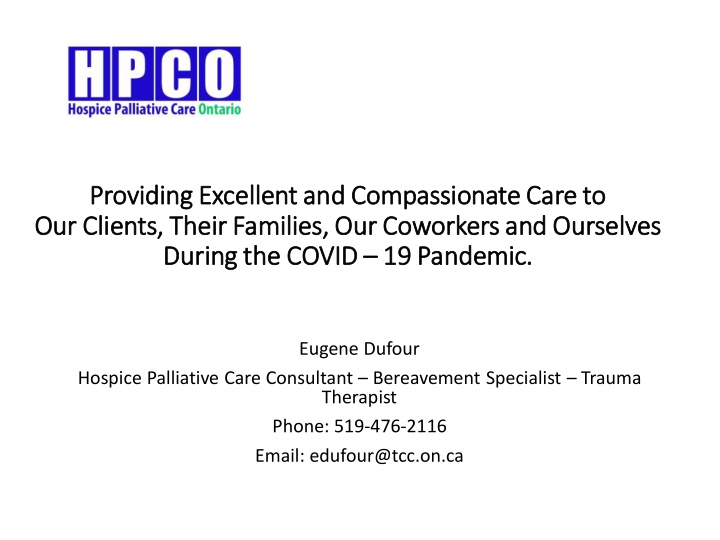



Providing Ex Exce cellent and and Com ompassio ionate Car are to Our ur Clie lients, The heir Fam amili lies, Our ur Coworkers s an and Our urselves Du During the COVID – 19 19 Pan andemic. Eugene Dufour Hospice Palliative Care Consultant – Bereavement Specialist – Trauma Therapist Phone: 519-476-2116 Email: edufour@tcc.on.ca
Sess ssion n Eigh ght: : Reviewi wing g and d Reass ssess essing ng Pr Pre-Post Traum umatic Stres ess - COVID-19 Stress - Compassion Fatigue - Trauma Symptoms - PTSD Symptoms - The Cycle of Cynicism - The Cycle of Hope - The Cycle of Self-Compassion - Guidepost For Diminishing Suffering
As human an being ngs s we are e st storytel eller ers. s. Trauma triggers within us the need to tell stories to make sense of what has happened. Stephan Joseph – What Doesn’t Kills Us
To o be be di diag agnosed wi with th PTS PTSD, an n adult dult mus must t ha have all l of f the he foll ollowin ing for or at at leas ast 1 1 mon month th: - At leas ast one e re-exper perienc encing ng sympt ptom om - At leas ast one e av avoi oida danc nce e sympt ptom om - At leas ast two arou ousa sal and d reac activity sympt ptom oms - At leas ast two cogni gnition on and d mood od symptom oms
Re Re-experie iencin ing Sy Symptoms: - Flashbacks — reliving the trauma over and over, including physical symptoms like a racing heart or sweating - Bad dreams - Frightening thoughts Avoid idance Sym ymptoms: - Staying away from places, events, or objects that are reminders of the experience - Avoiding thoughts or feelings related to the traumatic event
Ar Arou ousal l and and Reac eactiv ivit ity Symp ymptoms: - Being easily startled - Feeling tense or “on edge” - Having difficulty sleeping, and/or having angry outbursts Co Cogn gniti ition and and Mo Mood d Symp ymptoms: - Trouble remembering key features of the traumatic event - Negative thoughts about oneself or the world - Distorted feelings like guilt or blame - Loss of interest in enjoyable activities
Ri Risk sk Fact ctor ors for r PTSD Incl nclude: e: - Living through dangerous events and traumas - Getting hurt - Seeing people hurt or killed - Childhood trauma - Feeling horror, helplessness, or extreme fear - Having little or no social support after the event - Dealing with extra stress after the event, such as loss of a loved one, pain and injury, or loss of a job or home - Having a history of mental illness or substance abuse
Th The e Six Six Ne Needs of of Mou ourning ng Durin During ou our r journ journey thr throu ough gri rief and and mo mour urni ning, we e al all enc encoun unter six nee needs we e mus must t mee meet if f we e ar are to o hea heal: 1. 1. Ac Ackn knowledge the the rea eality of of the the dea death. 2. 2. Emb Embrace the the pai pain of of the the loss. oss. 3. 3. Rem emember r the the per person n who who di died ed. 4. 4. Develo De lop a a ne new w self elf-id identit ity. 5. 5. Search for Sea or mea meaning. 6. 6. Rece eceive sup upport rt fr from om othe others.
Resilien ence e Factors That Ma May Redu duce e the e Risk of PTSD Includ ude: e: - Seeking out support from other people, such as friends and family - Finding a support group after a traumatic event - Learning to feel good about one’s own actions in the face of danger - Having a coping strategy, or a way of getting through the bad event and learning from it - Being able to act and respond effectively despite feeling fear
Guid uidep epost For For Dim imin inis ishin ing Sufferin ing 1. Acknowledging Suffering and the Sufferer. 2. Inviting, Listening To, And Witnessing Stories Of Suffering. 3. Recognizing and Challenging Our Own Constraining Beliefs About Suffering.
Gu Guid idepost t For or Dimin inis ishing Suf Suffering 4. Creating A Healing Context For Reducing Suffering. 5. Inviting Reflections About Suffering 6. Reverencing And Loving 7. Prayer And Praying (Inspiration)
Healing does not mean the trauma never existed. It just means the trauma no longer controls our lives.
NEW COVID-19 RESOURCES COVID-19 SPECIFIC CONVERSATION GUIDES: • Proactive Goals of Care (GOC) conversations • GOC conversations for a person with mild/mod COVID-19 • GOC conversation for a person with severe COVID-19 • Phone conversations with families of a dying person OTHER COVID RESOURCES: • Palliative symptom management suggested order set for LTC • Advance Care Planning guides for patients and SDM • Sample letter from LTC facilities to families and residents ALWAYS AVAILABLE: • Advance Care Planning, Goals of Care and Consent resources for healthcare providers (conversation guides, e-learning modules) • Person-Centred Decision-Making Toolkit https://www.hpco.ca/
Recommend
More recommend